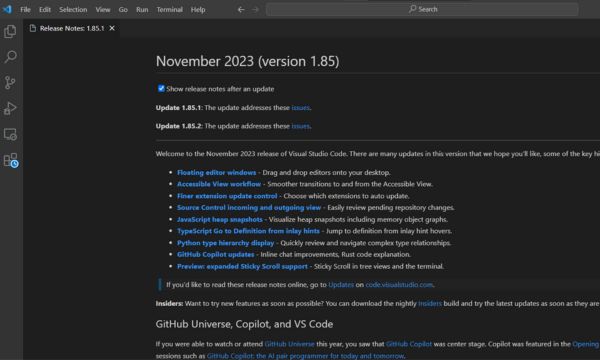Automating Web Development
Web improvement is an ever-evolving subject, and staying ahead of the curve calls for using effective gear that streamlines workflows, beautifies productiveness, and facilitates collaboration. Automation is important to efficiency in the quick-paced global world of web improvement. This article will explore the top five web development tools you need to automate your workflow and improve your development procedure.
Visual Studio Code (VSCode)

Visual Studio Code, advanced through Microsoft, has become the world’s go-to code editor for web builders. Its lightweight yet effective layout, coupled with an extensive library of extensions, makes it a necessary tool for automating diverse elements of the improvement procedure. With built-in Git integration, smart code of entirety, and a tremendous array of extensions for extraordinary programming languages and frameworks, VSCode significantly complements the coding revel in.
Moreover, VSCode’s incorporated terminal allows developers to run commands at once in the editor, streamlining responsibilities, which include strolling checks, handling model control, and initiating construct tactics. There is potential to personalize and automate obligations through obligations. JSON and release JSON documents quicken the improvement workflow, making VSCode a vital device for any web developer.
Webpack
Webpack is a powerful module bundler that automates the bundling and optimizing of assets in a web utility. As contemporary web development entails running with numerous properties, including JavaScript, CSS, and photos, manually coping with and optimizing these assets can be time-consuming. Webpack simplifies this method by automating the bundling, minifying, and optimizing these belongings.
Webpack’s capacity to address dependencies, code splitting, and warm module substitutes considerably improves the development workflow. With a properly-defined configuration report (webpack.Config.Js), builders can automate the complete construction process, ensuring the final output is optimized for overall performance. This now effectively saves time and leads to faster-loading web programs, ultimately improving user enjoyment.
Docker
Containerization has revolutionized how web programs evolve, deploy, and scale. Docker, a leading containerization platform, automates the packaging of an application and its dependencies right into a standardized field. This container can be deployed continually throughout diverse environments, avoiding the notorious “it works on my machine” issue.
By automating the containerization procedure, Docker simplifies the setup of improvement environments, making it easier for developers to paint on extraordinary projects without demanding conflicting dependencies. Additionally, Docker enables seamless collaboration among development, testing, and deployment teams, as the packing containers encapsulate the whole application stack. This automation now hastens the improvement system and ensures consistency and reliability throughout the software program improvement lifecycle.
Git and GitHub

Version management is fundamental to web development, and Git, combined with systems like GitHub, automates the monitoring of code changes, enables collaboration, and ensures code integrity. Git permits developers to create branches for one-of-a-kind features or worm fixes, merge adjustments easily, and roll again to preceding states if wanted. GitHub, as a web-primarily based platform constructed around Git, adds a layer of collaboration and automation to version manipulation. Features that include pull requests, code critiques, and continuous integration (CI) integrations automate and streamline the collaboration procedure.
CI tools like GitHub Actions or Jenkins can robotically construct, take a look at, and deploy code changes each time there’s a new devote or pull request. This degree of automation no longer complements code fine but also reduces the threat of introducing insects into the production environment.
Npm (Node Package Manager)
For initiatives leveraging JavaScript, npm is a critical tool for automating bundle management and dependency decisions. Npm, bundled with Node.Js, allows builders to define challenge dependencies in a package.Json document and install them automatically. This eliminates the need to manually download and manipulate libraries and frameworks, saving time and reducing the threat of model conflicts. NPM scripts offer a powerful way to automate numerous obligations, which include running assessments, bundling property, or beginning a nearby improvement server.
By defining those scripts within the package.json record, developers can execute complex workflows with an unmarried command. Additionally, npm allows clean sharing of code and libraries, fostering a colorful ecosystem and accelerating improvement by reusing present solutions.
JIRA and Confluence
Effective venture management and collaboration are critical additives to successful web development tasks. JIRA and Confluence, developed through Atlassian, provide a powerful duo to automate undertaking monitoring, problem management, and documentation. JIRA is a complete venture management tool, permitting groups to create user stories, plan sprints, and music progress via agile forums. Automation policies within JIRA may be configured to streamline repetitive obligations, such as transitioning issues, sending notifications, or updating fields. This, now not the most effective, reduces guide efforts; however, it additionally guarantees consistency and adherence to task workflows.
Confluence, on the other hand, complements JIRA by way of imparting a collaborative environment for growing, sharing, and organizing assignment documentation. With functions like live editing, inline comments, and integrations with other equipment, Confluence automates the method of documentation, making it smooth for crew members to live knowledgeable and contribute to the challenge’s knowledge base.
ESLint and Prettier
Maintaining pleasant and consistent code is vital in web improvement, especially when running a team. ESLint and Prettier are important equipment that automates code formatting and enforces coding requirements. ESLint is a linter that identifies and reviews patterns in JavaScript code, helping developers adhere to satisfactory practices and keep a steady code style. By integrating ESLint into your development procedure, you may catch capability problems and implement coding requirements mechanically. This, now not the most effective, improves code pleasant; however, it reduces the chance of introducing bugs.
Prettier, alternatively, focuses on code formatting, automatically remodeling code to stick to a predefined style manual. By configuring Prettier to work alongside ESLint, you could ensure that your codebase now follows great practices and appears steady. This combination automates the regularly tedious assignment of manual code formatting, allowing builders to be aware of writing code in preference to fixing formatting troubles.
Postman
Testing is an imperative part of the web development process, and Postman automates the trying out and debugging of APIs. Postman affords a consumer-friendly interface for developing and dealing with API requests, automating sending requests, and validating responses. With capabilities like computerized testing scripts, pre-request scripts, and collection runners, Postman permits developers to create comprehensive check suites for APIs.
This automation ensures that APIs function as predicted and facilitates the identification of ability issues early within the improvement cycle. Additionally, Postman’s collaboration features enable groups to percentage and run tests, fostering collaboration and expertise sharing in the trying-out segment of development.
Don’t Miss: Is Flutter Good For Web Development? Let’s Find Out
Conclusion
In the hastily evolving panorama of web development, automation is important to staying competitive and delivering incredible applications efficiently. The equipment stated – Visual Studio Code, Webpack, Docker, Git/GitHub, and npm – plays a pivotal function in automating unique aspects of the development workflow, from code enhancing and bundling to containerization and version manipulation.
By incorporating these types of equipment into your web improvement toolkit, you can streamline your workflow, reduce guide overhead, and focus on building sturdy and innovative internet applications. As the industry grows, embracing automation will beautify your productivity and role you as an ahead-wondering and green web developer within the ever-changing international technology arena.
FAQs
- Q: Why is automation important in web development?A: Automation helps you in enhancing your productivity and promotes collaboration which is crucial in today’s fast-paced world.
- Q: How does Visual Studio Code contribute to automation?A: VSCode provides you with various features be it smart code completion, built-in git integration, or integrated terminal, making tasks efficient.
- Q: What role does Docker play in web development automation?A: Docker automates packaging applications into standardized containers, ensuring consistent deployment across different environments.
- Q: How do Git and GitHub automate version control and collaboration?A: Git automates tracking code changes, while GitHub adds collaboration features like pull requests and code reviews, enhancing teamwork.
- Q: Why are ESLint and Prettier important in code maintenance?A: ESLint enforces coding standards, and Prettier automates code formatting, ensuring a consistent and high-quality codebase.
